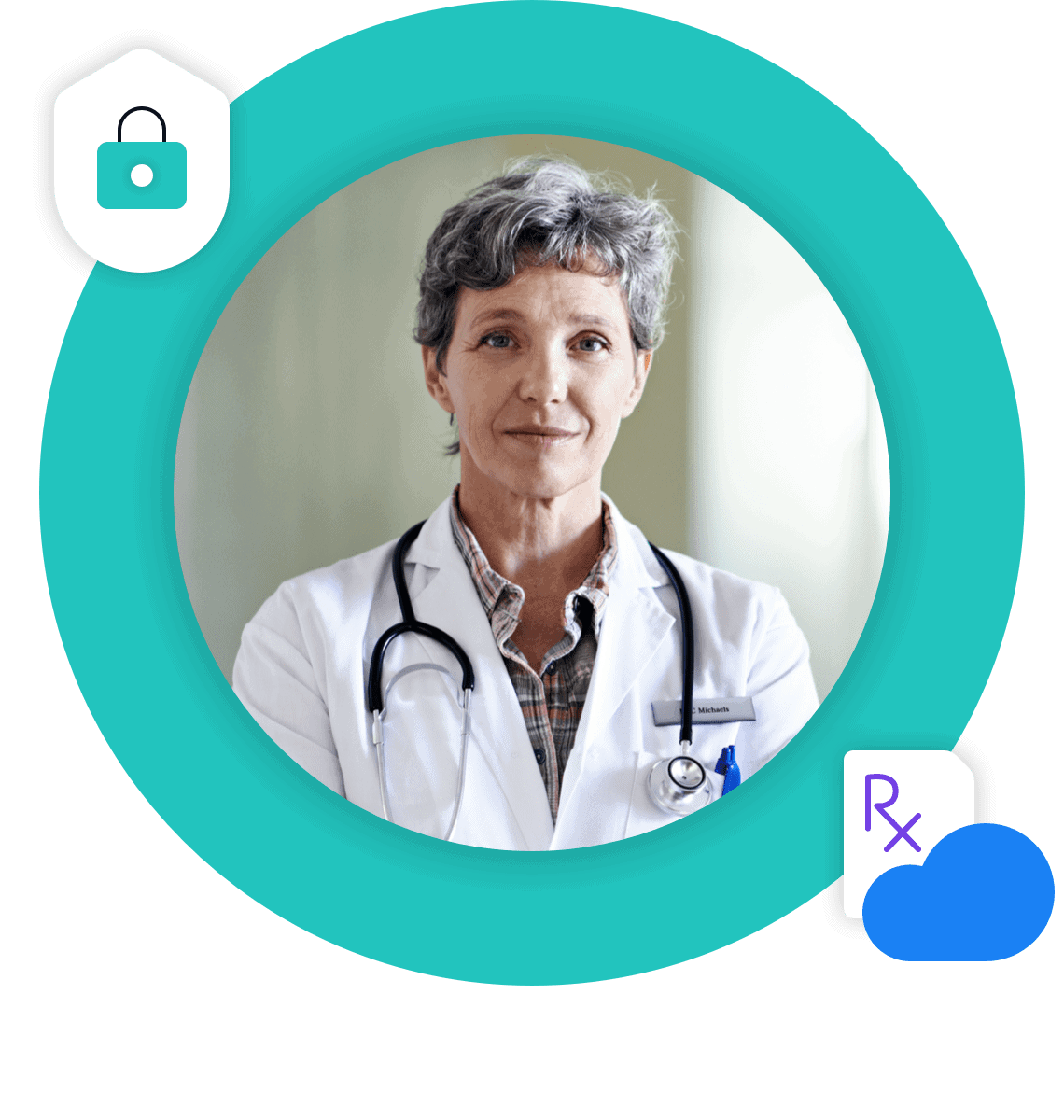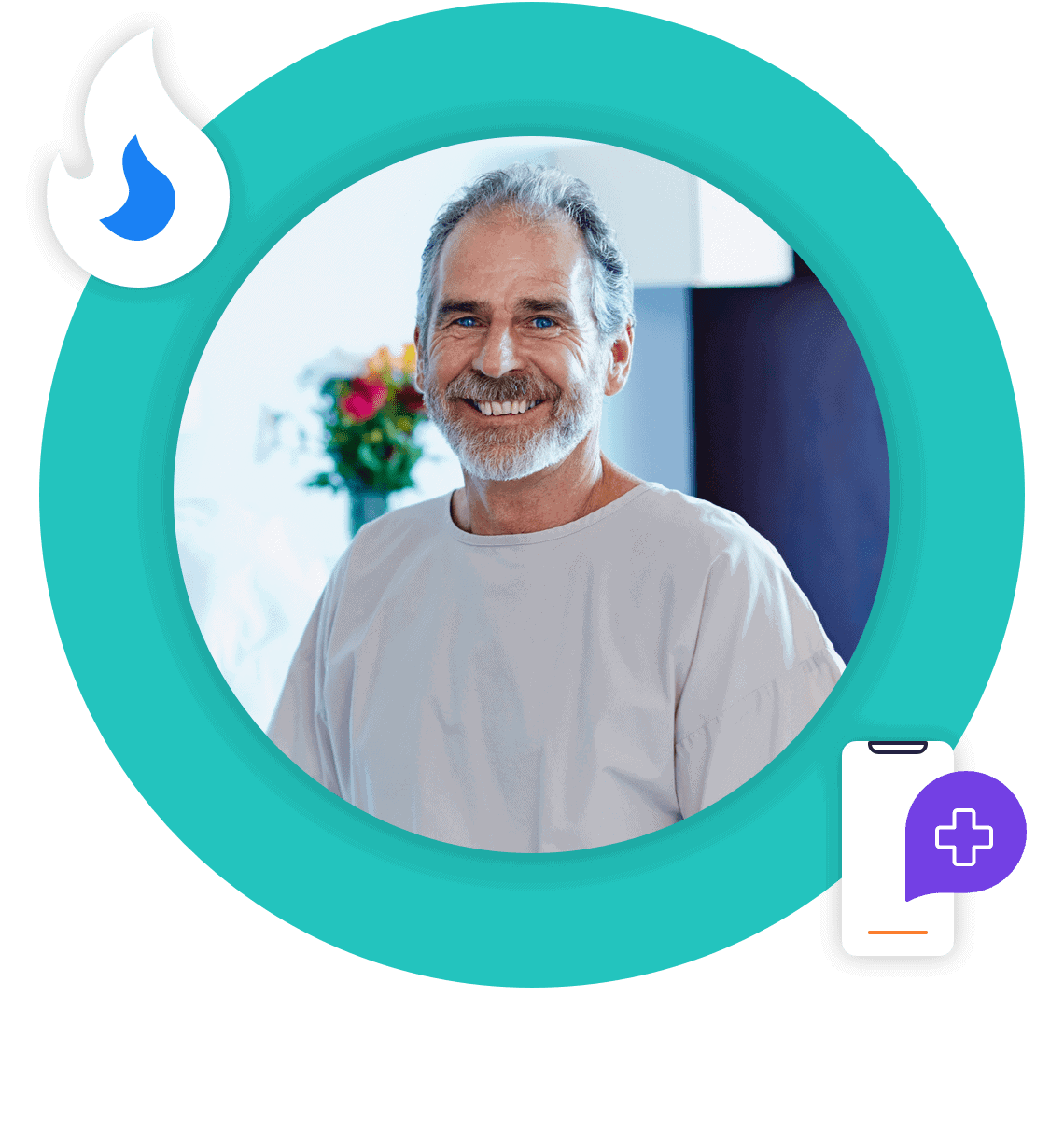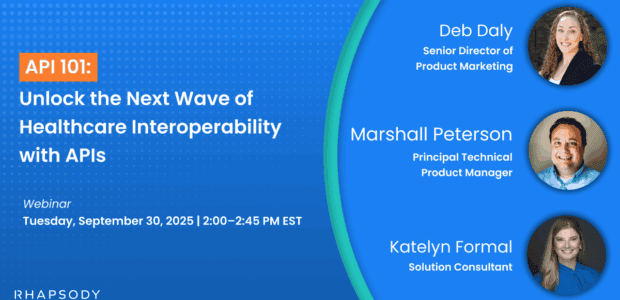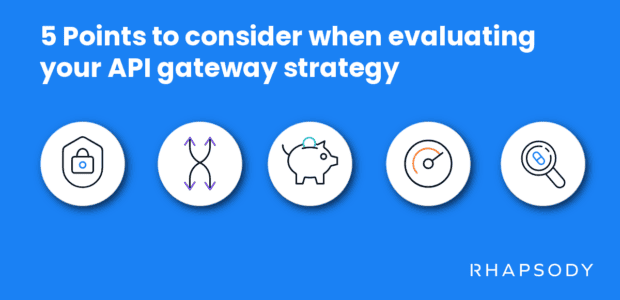Healthcare Integration
Turn healthcare data connections into a strategic advantage
Modern APIs. Point-to-point HL7. FHIR-native apps. Flat files. Rhapsody connects them all so you move faster, improve outcomes, and scale smarter.
Healthcare data doesn’t live in one place or speak one language. You need connections that work across EHRs, labs, imaging systems, payers, and everything in between without slowing down your strategy. Good integration is invisible. Rhapsody handles the complexity, transforming integration from a barrier into an accelerator.

Moving healthcare closer to plug-and-play interoperability.
Modern APIs and legacy protocols coexist in the healthcare industry. You need both to work seamlessly.
Rhapsody is API-centric, supporting REST APIs, FHIR, HL7v2, X12, DICOM, flat files, and custom formats. Whether you’re connecting to Epic’s FHIR APIs, processing ADT feeds, or building modern microservices, Rhapsody provides the infrastructure to connect, transform, and route data reliably.
From real-time event streams to batch processing, from cloud-native apps to on-premises systems, Rhapsody meets you where you are and innovates to prepare you for what’s next. Additionally, Rhapsody helps you meet regulatory requirements from the ONC, CMS, and other healthcare mandates that require standardized API access.
APIs and interfaces with any standard
Connect systems using REST APIs, FHIR, HL7v2, XDS, CDA, X12/EDI, SQL, AMQP, and more. Rhapsody adapts to both modern and legacy infrastructure.
Deploy in hours, not months
Simple API connections go live in hours. Standard integrations deploy in days. Complex workflows launch in weeks, not the months traditional interfaces require.
Built for security and scale
HITRUST certified, HIPAA compliant, SOC 2 attested. Rhapsody handles the security and reliability requirements healthcare demands. Expose APIs confidently with built-in authentication, access control, and threat protection.
Regulatory compliance built in
Meet ONC, CMS, and regional healthcare data-sharing mandates with FHIR-compliant APIs and audit-ready integration workflows. Stay ahead of evolving requirements.
How Rhapsody helps healthcare teams connect
any system
Rhapsody provides the infrastructure layer healthcare organizations need to exchange data across any standard, any system, any deployment model. Our integration solutions — Rhapsody Integration, Corepoint Integration, Rhapsody Envoy, and API Guardian — make it easier to connect applications, share data, and power better healthcare outcomes.
Learn about Rhapsody solutions
Why API integration is transforming healthcare delivery
Unlike point-to-point connections or rigid interfaces, APIs let health IT teams standardize how systems communicate, making it easier to add new applications, scale existing ones, and support modern workflows.
Rhapsody is API-centric. You can:
- Expose data from any source system through standardized REST APIs
- Orchestrate complex workflows across multiple systems
- Transform legacy protocols (like HL7v2) into modern API calls
- Support both synchronous and asynchronous patterns
Whether you’re a health system modernizing infrastructure or a digital health company building patient-facing apps, Rhapsody’s API capabilities reduce development time and improve system reliability.
APIs utilize widely adopted technologies familiar to developers across industries, including REST, JSON, and OAuth. This means a larger talent pool, faster onboarding, and abundant training resources, unlike proprietary healthcare integration technologies.

API integration for patient portals and consumer health apps
Healthcare consumers expect the same digital experience they get in other industries. APIs enable the delivery of patient-facing applications that put health data directly in patients’ hands.
Rhapsody enables secure connections to:
- Patient portals and mobile health applications
- Wearable devices and remote monitoring platforms
- Consumer health apps for scheduling, messaging, and care coordination
- Personal health record systems
Support for SMART on FHIR and OAuth 2.0 ensures patients control their health information while maintaining security and privacy standards. Empower patients to actively participate in their care while meeting regulatory requirements for patient data access and privacy.

FHIR: The modern standard regulators mandate, and innovators build on
Fast Healthcare Interoperability Resources (FHIR) is the modern standard for real-time healthcare data exchange by API. Regulators mandate it, EHR vendors support it, and digital health innovators build on it. FHIR is not optional; it’s the foundation of modern healthcare data exchange.
Rhapsody provides native FHIR support, including:
- FHIR data exchange
- Built-in FHIR validation and transformation
- Support for SMART on FHIR authentication
- Support for Bulk FHIR for population health and analytics
Connect to any FHIR-enabled system, including Epic, Cerner Oracle Health. Transform between FHIR and legacy formats. Build FHIR-first applications without worrying about underlying infrastructure.
While FHIR provides essential standardization, healthcare also needs flexibility for cutting-edge innovation. Rhapsody supports both FHIR standards and custom APIs, so you’re compliant with regulations while staying free to innovate beyond current specifications.

HL7v2 and legacy protocol support
HL7v2 isn’t going anywhere, and Rhapsody handles it expertly. Most healthcare data still flows through HL7v2 feeds, including ADT messages for admissions and transfers, ORM/ORU for orders and results, and CDA for clinical documents.
Rhapsody excels at:
- Processing high-volume HL7v2 message streams
- Transforming between HL7 versions, custom implementations, and other standards
- Routing messages based on complex business logic
- Bridging HL7v2 systems with modern FHIR applications
Plus support for X12/EDI for claims processing, DICOM for imaging workflows, custom flat files, and support for standards like XDS, SQL, AMQP – all managed through one platform.

APIs aren’t optional, federal regulations now mandate them
Governments worldwide have created policies enforcing and incenting healthcare data exchange via API and FHIR standards. In the US, healthcare organizations face strict deadlines for implementing API-based patient access and data exchange. Non-compliance risks include penalties and damage to reputation.
ONC 21st Century Cures Act Final Rule…
mandates certified EHR technology support standardized FHIR-based patient access APIs and prohibits information blocking. Enforcement began in 2022 with penalties escalating for violations.
CMS Interoperability Final Rule…
requires payers (Medicare Advantage, Medicaid, CHIP, QHP issuers) to implement patient access APIs and payer-to-payer data exchange.
Customer-proven results
Integration that delivers measurable impact
Healthcare organizations rely on Rhapsody to reduce complexity, accelerate deployment, and ensure reliability – earning a 98% customer retention rate.
90%
of engineering time refocused to roadmaps and innovation
50%
faster integration build time for new system and customer onboarding
193%
ROI over three years
1000+
days with no unplanned downtime
What healthcare teams say about connecting with Rhapsody
Integration challenges are universal in healthcare.
Rhapsody helps you solve them.
“With Rhapsody Integration Engine, we’re now ready to accommodate vendors who want to connect to Phoenix Children’s using FHIR. By all accounts, FHIR is the future of healthcare data integration, and we’re excited to have a partner like Rhapsody by our side as we venture into it.”
Kevin Allen
Senior Integration Analyst, Phoenix Children’s Hospital
“Rhapsody solutions and FHIR work perfectly together for building a storage layer. It’s one of the best methods I’ve seen for normalization of multiple inbound data sources.”
Jason Setters
Senior Architect, Data Integration, Press Ganey
“Rhapsody allows all the functions that we utilize to speak with each other, whether it’s HL7, FHIR, SOAP – doesn’t matter. They can all speak with one another.”
Anthony Concolino
Sales Manager, Medrics
Strategic benefits of the right integration platform
Start with strategy, not technology
Successful integration begins with understanding your objectives:
- How can data exchange improve analytics?
- Which clinical workflows need better data access?
- Which third-party applications require integration for go-liveEHR connectivity?
- What patient engagement capabilities do stakeholders want?
- What compliance requirements drive your timeline?
Rhapsody helps healthcare organizations assess their integration needs to develop phased deployment strategies.
Reduce costs and accelerate deployment
Integration projects stretch timelines and budgets when you’re fighting outdated infrastructure. Rhapsody’s standard integrations, flexibility, automation capabilities, and healthcare-specific tooling cut integration time by half, letting teams deploy new connections in weeks instead of months.
Support value-based care, IT, and operational strategies simultaneously
Migrating EHRs? Modernizing to cloud? Building patient-facing apps? Expanding population health analytics? You don’t have to choose. Rhapsody supports all these initiatives on one platform, reducing vendor complexity and operational overhead while maintaining a single source of integration truth.
Improve data quality at scale
Leverage Rhapsody’s patient identity matching and terminology standardization solutions to improve data quality across the board. With every application in your ecosystem able to call via API, you’ll create a unified, reliable data environment you can trust
Master healthcare API integration
From implementation guides to real-world case studies, explore resources that help you make smarter integration decisions and deploy faster.
Resources for health data integrationStart building your healthcare API solutions today
Connect with our healthcare integration experts to discover how Rhapsody can streamline your infrastructure, simplify integration complexity, and accelerate your digital health initiatives.
Common questions about connecting healthcare systems
How do APIs differ from traditional healthcare interfaces?
How do APIs improve data security compared to traditional interfaces?
Can Rhapsody connect to any EHR system?
What regulatory requirements does Rhapsody help us meet?
How does Rhapsody help with compliance auditing?
What if we have custom or proprietary formats?
How does Rhapsody handle both real-time and batch integration?
Is Rhapsody cloud-based or on-premises?
How does Rhapsody support clinical decision support and real-time analytics?
Can patients access their data through Rhapsody-powered APIs?
How does Rhapsody compare to building integrations directly with EHR vendor APIs?
Why are healthcare organizations moving from traditional interfaces to APIs now?
How long does implementation typically take?
- Simple API connections: Hours to days
- Standard integrations: Days to 2 weeks
- Complex multi-system workflows: 4–8 weeks
- Traditional custom interfaces without Rhapsody: Months



